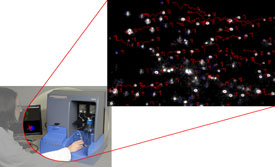Salisbury, UK, 14th March 2011: NanoSight, world-leading manufacturers of unique nanoparticle characterization technology announce the release of Zeta Potential Analysis applying Z-NTA, particle by particle characterization of surface charge. Z-NTA will make its public debut at the US Pittsburgh Conference & Exposition being held in 2011 in Atlanta, Georgia from March 14th until 17th, booth #519.
Zeta Potential Nanoparticle Tracking Analysis (Z-NTA) adds measurement of surface charge to simultaneous reporting of size, composition (light scattering intensity), fluorescence and count. As with NTA, the core of NanoSight’s world-accepted nanoparticle measurement systems, it collects data on a particle-by-particle basis. No other methodology comes close to providing such simultaneous, multiparameter nanoparticle characterization.
Zeta potential is measured particle-by-particle, simultaneously for the complete sample population to provide data that is number weighted not intensity weighted. Size and light scattering intensity are also reported. Polydisperse and complex suspensions are readily characterized. No labelling is required but a fluorescence mode option is available to further differentiate suitable-labelled sub-populations. All data sets are validated by real time observation of particles moving under both electrophoretic and Brownian motion.
The user benefits are clear to define. Variations in zeta potential with size are analyzed with positively and negatively charged particles being reported separately even when they exist together. Sub-populations of similar sized particles of different materials, differentiated by their propensity to scatter light, are separately reported and counted. As with size distribution measurement, changes in Zeta Potential distribution with pH, concentration and temperature may be studied. Similarly, aggregation and flocculation may be studied quantitatively in real-time. Suitable labelling can highlight one sub-population for analysis despite high background noise.
With applications transcending the life sciences through the materials sciences, NanoSight have installed more than 300 systems worldwide as NTA-based characterization becomes increasingly accepted as the technique to quantitatively study nanoparticles. To learn more about nanoparticle characterization using Nanoparticle Tracking Analysis, NTA, please visit the company website (www.nanosight.com) and register for the latest issue of NanoTrail, the company’s electronic newsletter.

NanoSight’s NTA software showing particles moving under electrophoretic and Brownian motion - ZetaSight
To download a high resolution version (1640 x 995 pixels), please click on the image above.
About NanoSight
NanoSight delivers the world’s most versatile and proven multi-parameter nanoparticle analysis in a single instrument.
NanoSight visualizes, measures and characterizes virtually all nanoparticles. Particle size, concentration, Zeta potential and aggregation can all be analyzed while a fluorescence mode provides differentiation of labelled particles. NanoSight presents real time monitoring of the subtle changes in the characteristics of particle populations with all of these analyses uniquely confirmed by visual validation.
NanoSight’s “Nanoparticle Tracking Analysis” (NTA) detects and visualizes populations of nanoparticles in liquids down to 10nm, dependent on material, and measures the size of each particle from direct observations of diffusion. This particle-by-particle methodology goes beyond traditional light scattering and other ensemble techniques in providing high-resolution particle size distributions. Additionally, NanoSight measures concentration and validates data with information-rich video files of the particles moving under Brownian motion.
NanoSight’s comprehensive characterization matches the demands of complex biological systems, hence its wide application in development of drug delivery systems, of viral vaccines, in nanotoxicology and in biodiagnostics. This real-time data gives insight into the kinetics of protein aggregation and other time-dependent phenomena in a qualitative and quantitative manner.
NanoSight has a growing role in biodiagnostics, being proven in detection and speciation of nanovesicles (exosomes) and microvesicles. As functionalized nanoparticles increasingly fulfill their potential in biodiagnostics, NanoSight is ever more the analytical platform of choice.
NanoSight demonstrates worldwide success through rapid adoption of NTA, having installed more than 300 systems worldwide with users including BASF, GlaxoSmithKline, Merck, Novartis, Pfizer, Proctor and Gamble, Roche and Unilever together with the most eminent universities and research institutes. In addition to this user base more than 150 third party papers citing NanoSight results consolidate NanoSight’s leadership position in nanoparticle characterization. For more information, visit the NanoSight website (www.nanosight.com).
For further information
Please contact NanoSight direct or their marketing agency, NetDyaLog Limited:
NanoSight Limited
Minton Park
London Road
Amesbury SP4 7RT
T +44 (0) 1980 676060
F +44 (0) 1980 624703
NanoSight website
[email protected]
NetDyaLog Limited
39 de Bohun Court
Saffron Walden
Essex CB10 2BA
T +44 (0) 1799 521881
M +44 (0) 7843 012997
NetDyaLog website
[email protected]